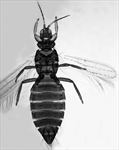
Female

Head & pronotum

Antenna

Antennal segments III and IV
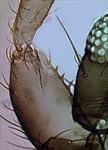
Fore femur
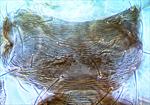
Pronotum
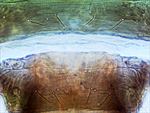
Tergites VII–VIII
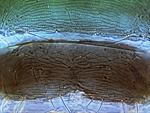
Sternites VI–VII

Fore wing
Female fully winged. Body, legs and antennae brown, except fore tarsi, fore tibiae and antennal segment III and sometimes IV yellow; fore wings shaded distally but pale near base. Antennae 9-segmented, segment IX longer than VIII; segment III apparently without sensoria, IV with 1 small oval sensorium. Head relatively long with 2 pairs of long postocular setae. Pronotum with many prominent setae, about 5 pairs on anterior margin and 5 pairs on posterior margin. Mesonotum with many microtrichia. Metanotum with only one pair of setae, sculpture arcuate around anterior margin and with many microtrichia. Fore femur with 1–4 small moderately stout setae on inner margin. Fore tarsal hamus recurved. Fore wing broad with apex rounded. Abdominal tergites with transverse lines of sculpture. Sternites IV–VI with 3 pairs of marginal setae and 5–6 discal setae medially but not laterally, completely covered with microtrichia; sternite VII with discal setae laterally and 2 pairs of supernumerary setae sub-medially.
This species has antennal segment III pale, but the pronotum bears only three pairs of well-developed discal setae in contrast to ephedra and spinosus. Currently there are nine species described in the genus Dactuliothrips; five are from California and four from Argentina.
Breeding in the flowers of Yucca brevifolia [Agavaceae].
Recorded only from California
AEOLOTHRIPIDAE
Dactuliothrips xerophilus Bailey
Dactuliothrips xerophilus Bailey, 1937:122
Pereyra V & de Borbon CM (2013) The American genus Dactuliothrips (Thysanoptera: Aeolothripidae) with three new species. Zootaxa 3734 (1): 001–014.